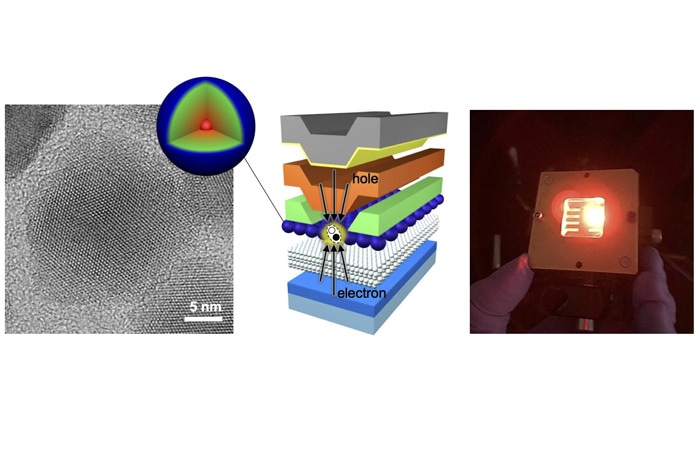Nov 21 2017
Scientists at Los Alamos National Laboratory have demonstrated how light can be successfully amplified using electrically stimulated films of quantum dots – the chemically synthesized semiconductor nanocrystals. This breakthrough development represents an important step towards solution-processible laser diodes.
 A collage showing a transmission electron microscopy image of the improved quantum dot and its representation (left), the schematic of the device which illustrates “current-focusing” idea (middle), and the device under operation (right). (Credit: Los Alamos National Laboratory)
A collage showing a transmission electron microscopy image of the improved quantum dot and its representation (left), the schematic of the device which illustrates “current-focusing” idea (middle), and the device under operation (right). (Credit: Los Alamos National Laboratory)
The quantum dot films are incorporated into devices that resemble light-emitting diodes (LEDs), which are currently ubiquitous, but in this case these films are designed to maintain the high current densities needed to achieve the optical-gain regime. Laser diodes are often seen every day in barcode readers, laser pointers, etc. and a core element of these devices is an optical-gain medium, which amplifies the incident light, instead of absorbing it
Optical gain with electrically excited quanum dots is now a reality,”We have been working to develop new lasing media, using chemically synthesized quantum dots, although it had been widely believed that quantum dot lasing with electrical stimulation is simply impossible, by using our specially designed dots, we can avoid energy losses created by Auger recombination.
Victor Klimov, head of the quantum dot team at Los Alamos
New lasers, made more efficiently
These latest results could pave the way for a new range of highly flexible, electrically pumped, solution- processible laser diodes that can complement or ultimately replace today’s laser diodes developed using costly and more complex vacuum-based epitaxial methods. These potential devices can give way to a host of applications, ranging from RGB laser modules for projectors and displays to multi-wavelength micro-lasers for chemical and biological diagnostics.
Designer dots with no heat loss
The results of the study have been reported in Nature Materials, where the Los Alamos team showed that they can successfully amplify light in a nanocrystal solid with direct-current electrical pumping, using their “designer” quantum dots. A carefully designed particle interior, in which the composition of the material is continuously changed along a radial direction, represents the main property of the new quantum dots, underscoring the success of the study performed. This method eliminates the sharp steps involved in the atomic composition which would usually set off Auger recombination. Therefore, the engineered quantum dots feature almost complete suppression of Auger effect’s heat loss, and this makes it possible to redirect the energy which is discharged by the electrical current into the light-emission channel rather than wasteful heat.
In 2000, the nanotechnology team at Los Alamos originally found out the lasing effect in semiconductor nanocrystals. These proof-of-principle experiments were published in the journal Science, where the quantum dots were excited with very short (femtosecond) laser pulses utilized to outcompete the optical gain decay induced by the Auger process. In the case of electrical pumping, short optical gain lifetimes present a particularly serious problem, which is an inherently slow process as holes and electrons are injected one-by-one into the quantum dot.
Staying focused
A special “current-focusing” device architecture is another key element of this work, enabling the high current densities required for acquiring optical gain. Los Alamos researchers used a method in which one of the charge-injection electrodes is tapered and the size of the current-conducting area is thus reduced to less than 100 microns. The researchers used this strategy to create sufficient current concentration to reach the light amplification regime, without affecting either the injection layers or the quantum dots.